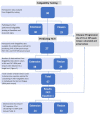Use of Fatigue Index as a Measure of Local Muscle Fatigability in Ryanodine Receptor Isoform-1-Related Myopathies
- PMID: 31920904
- PMCID: PMC6914942
- DOI: 10.3389/fneur.2019.01234
Use of Fatigue Index as a Measure of Local Muscle Fatigability in Ryanodine Receptor Isoform-1-Related Myopathies
Abstract
Introduction: Individuals affected with ryanodine receptor isoform-1-related myopathies (RYR1-RM) commonly experience fatigability in the quadriceps, which may limit physical function and potentially diminish quality of life. Fatigability, in RYR1-RM, results from skeletal muscle injury secondary to dysfunction of the major skeletal muscle Ca++ channel. However, during fatigability testing, affected individuals did not always reach the point of local muscle fatigue as defined by a fatigue index (FATI) at 50% of peak torque. Surakka et al. compared three versions of FATI equations, which vary by the area under the force curve (AUC). By performing this comparison, they were able to determine the optimal equation in individuals with Multiple Sclerosis. Purpose: Using a similar comparison, we sought to identify the optimal FATI equation in the RYR1-RM population. Secondly, because local muscle fatigability might have an impact on independent living, this study also assessed change in local muscle fatigability over a 6-month time frame. Methods: Thirty participants were analyzed from the RYR1-RM natural history study and double-blind, placebo-controlled N-acetylcysteine (NAC) trial, NCT02362425. Twenty-seven had fatigability data, from isometric knee extension and flexion fatigability tests, available for the purpose of establishing a method for predicting FATI at 50% peak torque. For the natural history study, 30 participants were used to assess disease progression of local muscle fatigability achieved during the knee extension fatigability test, and 29 participants for the knee flexion fatigability test. Results: Surakka's equation 1, using the prediction approach, led to the smallest median error, the smallest square-root of uncorrected sum of squares, and the smallest average of the absolute value of the differences. No difference was observed in FATI at 50% peak torque between month 0 and month 6 for extension (p = 0.606) and flexion (p = 0.740). Conclusion: Surakka's equation 1, with the prediction approach, was found to be the most accurate for imputing values when fatigue was not reached during a sustained knee isometric fatigability test in RYR1-RM. Furthermore, when used to assess fatigability-based disease stability, local muscle fatigability, in this RYR1-RM population remained stable.
Keywords: RYR1-RM; fatigability; fatigue index; muscle; neuromuscular.
Copyright © 2019 Witherspoon, Rekant, Wakim, Vasavada, Waite, Chrismer, Shelton, Jain and Meilleur.
Figures




Similar articles
-
6-minute walk test as a measure of disease progression and fatigability in a cohort of individuals with RYR1-related myopathies.Orphanet J Rare Dis. 2018 Jul 3;13(1):105. doi: 10.1186/s13023-018-0848-9. Orphanet J Rare Dis. 2018. PMID: 29970108 Free PMC article.
-
Randomized controlled trial of N-acetylcysteine therapy for RYR1-related myopathies.Neurology. 2020 Mar 31;94(13):e1434-e1444. doi: 10.1212/WNL.0000000000008872. Epub 2020 Jan 15. Neurology. 2020. PMID: 31941795 Free PMC article. Clinical Trial.
-
Understanding Symptoms in RYR1-Related Myopathies: A Mixed-Methods Analysis Based on Participants' Experience.Patient. 2020 Aug;13(4):423-434. doi: 10.1007/s40271-020-00418-7. Patient. 2020. PMID: 32329019 Free PMC article. Clinical Trial.
-
Review of RyR1 pathway and associated pathomechanisms.Acta Neuropathol Commun. 2016 Nov 17;4(1):121. doi: 10.1186/s40478-016-0392-6. Acta Neuropathol Commun. 2016. PMID: 27855725 Free PMC article. Review.
-
Role of ryanodine receptors.Crit Rev Biochem Mol Biol. 1994;29(4):229-74. doi: 10.3109/10409239409083482. Crit Rev Biochem Mol Biol. 1994. PMID: 8001396 Review.
References
-
- Arafah A, Kuspinar A, Mayo N. Untangling perception of fatigue and fatigability: first steps. Austin J Multiple Scleros Neuroimmunol. (2015) 2:1018–25.
-
- Surakka J, Virtanen A, Aunola S, Mäentaka K, Pekkarinen H. Reliability of knee muscle strength and fatigue measurements. Biol Sport. (2005) 22:301–13.
LinkOut - more resources
Full Text Sources

